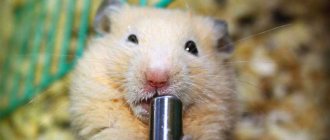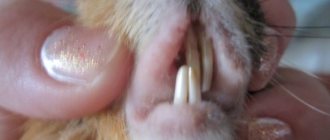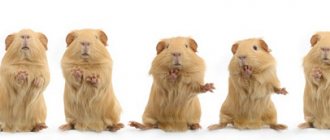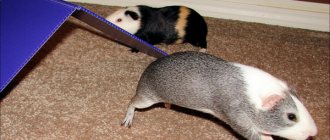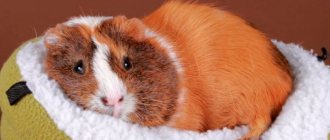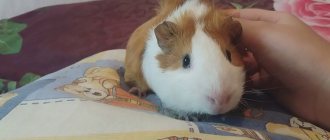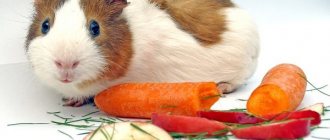- home
- Guinea pig
- Guinea pig health
02/18/2019 The guinea pig’s body needs a certain amount of fluid every day. The animal receives it both from the drinking bowl and from succulent food. The volume of clean water consumed by a pet serves as an indicator of its health status - normal or deteriorated. A sick animal loses not only its appetite, but also its desire to drink. But there are also frequent cases when a decrease in a rodent’s fluid intake is not associated with the development of the disease and the reason lies elsewhere. To understand why a guinea pig does not drink water, you should observe your pet for several days.
Guinea pig doesn't drink water
Like any other pet, a guinea pig needs water.
Absence can have a significant impact not only on health and activity, but also on vitality. Thirst can be influenced by: the amount of dry and succulent food, age, room temperature, activity, and finally, sweets and other not recommended foods. By getting enough moisture from greens and vegetables, water may be virtually unnecessary. In the wild it is used quite rarely. There can be many reasons why a pet refuses to drink; the main ones will be discussed below. A guinea pig does not drink water for the following reasons:
- The diet includes a sufficient amount of juicy vegetables, herbs and greens;
- The pig is experiencing stress, which may be associated with moving to a new cage. Very often, pets are plunged into this state after purchasing them.
- Not taught to drink from a drinking bowl. Perhaps previously only a bowl was available, and that is what the pet will be looking for.
- The drinking bowl is hung outside the reach, for example, a little high. Ideal placement at head level so you don't have to stretch to get a drink.
- Technical malfunction of the drinker. Check whether the ball in the tube allows water to pass through; perhaps the channel is clogged;
- The fluid is rotten or very old. To be replaced with a fresh one every 2-3 days (ideally daily).
If your pig used to drink water, but now has stopped, it may be that the diet has now included everything it needs. There is enough moisture and there is no need to resort to searching for additional moisture. Another option is that there is a desire, but there is no opportunity. Twist the ball with your finger; if a drop does not come out, then you need to clean it.
We make the drinker ourselves
If you don’t have extra funds or want to avoid low-quality hazardous materials, you can try making a drinking bowl yourself. To make a ball sippy cup, you will need:
- pen;
- plastic bottle;
- bearing (bicycle);
- sandpaper;
- silicone based sealant;
- stationery knife.
Step-by-step making of a ball drinker with your own hands:
1. It is necessary to disassemble the handle into its components - you will need its body. 2. Remove the ball from the bearing. 3. Next, you should place the ball in the body from the handle; it usually locks. Make a notch at this point; the unnecessary part needs to be cut off (you can use a hacksaw). 4. Blow into the handle, if there is an air passage, you need to remove excess parts, fixing the ball tightly. 5. Make a hole at the bottom of the plastic container to insert the pen body. 6. To avoid water leakage, apply sealant at the joint. 7. It is necessary to fix the former handle at an angle of 45 °, so the water will flow freely when acting on the ball.
The advantages of a home drinking bowl are that it is made with love for your pet and has a long service life. Disadvantages - not everyone can do this on their own; children will have to resort to the help of adults.
Why doesn't my pig drink water after moving?
Having bought an excellent guinea pig in the store, you bring it to a new cage prepared in advance. The cage is equipped with everything necessary, but she stands in a stupor and does not want to eat or drink. What to do in such a situation? First, understand that this is not a protest. We need to let her survive this, a new place is serious stress. Now she has one need - to find a secluded place where she can hide and get used to the new environment. It’s very good if you have a dark house or at least a pile of hay at your disposal that you can climb into.
The need for water is often experienced by the same animals whose diet includes dry food. They, eating only natural food, often do not drink liquids at all. But a drinking bowl with fresh water is a must.
There is no need to force water; if you think that your pet does not know how to drink from a drinking bowl, then simply teach him to do so. Run your finger along the tip of the tube so that a drop comes out (the animal should see it), you can wet your pet’s nose so that he can feel what it is. It would be enough. But mostly even such manipulations are not necessary. If the liquid is fresh and there is a real need, the pig will feel where it can drink on its own.
It doesn’t matter what kind of water you give, the main thing is that it is fresh and without chlorine or other additives.
For reasons unknown to me, some people ask “how long can a guinea pig live without water.” There is no definite answer, since everything depends on so many factors. The main ones are diet, temperature and activity. If it is possible to eat succulent food, herbs and vegetables all year round, then it will survive for years. But if there is a critical lack of moisture, the period can be reduced to a month.
Source
Rules for caring for a rodent
Any animal needs a mate, it won’t “last” long alone, but if you bought a male and a female, then don’t let it be a surprise for you that they will have offspring 60-70 days after the first “meeting”.
In the future, the female will go into heat again after 14-18 days. You should not be too lenient about frequent matings: the mother’s body wears out faster from frequent farrowing.
But demanding abstinence from a male is also not the best solution to limit childbearing. Guinea pigs, like rats and other rodents, are very fertile: if farrowing brings from 1 to 5 cubs, repeated every 2 months, it is easy to calculate the possible litter for the year.
Whether or not you should have more than one pair of pigs is up to you. Please note that newborn pigs themselves will be able to bear fruit and reproduce within 40 - 60 days (depending on gender).
Consider the question of where the newly born offspring will be placed and where the males will be placed so that overcrowding does not lead to a deterioration in the health of your pets.
When transporting home, try to do it quickly, but in such a way that the pig is as calm as possible: do not shake, do not turn over, do not sharply tilt the box and let there be hay inside if the journey is long.
If the pig does not eat for 2-3 days after transportation, this is stress, leave it alone. The following can be said about “living conditions”: the pen-cage must be clean, warm (but not hot), and so that the pig does not “share living space” with hamsters, rats and other living creatures.
If there is an angry dog or cat in the house, make sure they get along. If this does not happen, there is another reason to abandon the animal, because it will regularly get scared or get damaged, and its life will not be too long.
Is it normal for a guinea pig not to drink?
As it turns out, a healthy guinea pig fed a diet of liquid-rich vegetables (especially celery and cucumber) does not often need additional water. They seem to be able to get all the fluid they need from their vegetable diet—now you can see why it's so important to feed your guinea pig fresh vegetables every day! Guinea pig pellets and hay are also part of a pig's diet, but fresh, nutritious, and water-filled vegetables are truly essential to the health of your guinea pig.
Many people notice that as their guinea pig's vegetable intake increases, their alcohol intake decreases. This is no cause for concern and may even suggest that you are feeding your guinea pigs very well!
Water consumption changes throughout their lives
It's also worth noting that a guinea pig's water intake can change over the course of their life. As my boar guinea pig got older (and had a diet richer in the celery and cucumber mentioned above), he almost completely stopped drinking from his water bottle. And yet he remains happy, healthy and cheerful.
Why doesn't my guinea pig drink water and is this normal?
A guinea pig's body needs a certain amount of fluid every day. The animal receives it both from the drinking bowl and from succulent food. The volume of clean water consumed by a pet serves as an indicator of its health status - normal or deteriorated. A sick animal loses not only its appetite, but also its desire to drink. But there are also frequent cases when a decrease in a rodent’s fluid intake is not associated with the development of the disease and the reason lies elsewhere. To understand why a guinea pig does not drink water, you should observe your pet for several days.
General feeding rules
The recommended daily ratio of all types of food looks like this:
- dry food – 5-10% (no more than a tablespoon); juicy food – 30%; hay – 60%.
If there is no dry food on the menu, an adult pig should eat approximately 150 g of vegetables per day . She is served vegetables every day, and is occasionally pampered with berries and fruits. Vegetable dishes must be supplemented with leafy greens, which compensate for the lack of vitamins.
Do not keep your rodent on a mono-diet, feeding it only carrots or beets: this will cause health problems. It’s great if there are different products on his table every day: parsley will be replaced by dill/basil, and celery by carrots/zucchini. A typical daily diet consists of three types of vegetables and herbs.
Important! Do not collect plants near highways, factories, or in swampy areas. Dry the grass for at least 1.5-2 months: it should not be blackened or rotten.
Do not forget to establish an uninterrupted supply of hay (especially during the cold period): the guinea pig chews it constantly, without limiting itself in volume. Hay normalizes digestion and is necessary for proper grinding of teeth.
Legume and legume-cereal hay is considered the most valuable. The rodent will also thank you for the vitamin herbs (nettle, alfalfa and clover) that you will prepare in the summer. These plants will be an excellent feed for growing and pregnant animals.
When is a Guinea Pig Not Drinking Water Normally?
The optimal daily volume of liquid that a rodent should drink is about 200 ml. The animal should always have plenty of water, so it is recommended to install drinking bowls with a capacity of 250 ml or more in the pet’s cage. The amount of water provided in reserve will allow the animal to consume as much water as it wants during the day.
If your pig stops drinking water, this does not necessarily mean that she has an illness. Sometimes the animal consumes little water or does not drink at all without experiencing health problems.
Several reasons why a pet neglects to drink, not related to diseases, have been identified. The main one is poor water quality. Drinks may be stale, contaminated, stale, and have an unpleasant odor and taste. An unwashed drinking bowl can contribute to this - a dirty container will spoil even the cleanest water. In order not to deprive the animal of the necessary drink, it is important to regularly wash the drinking bowl and update its contents.
The second reason why a guinea pig does not drink water or drinks little is a change in diet. But it is worth noting that not all adjustments made to the pet’s menu produce such an effect. For example, if you increase the amount of dry food provided, guinea pigs drink more water.
Dietary changes that can help reduce thirst in a rodent include:
- Increasing the volume of juicy menu components - fruits or vegetables.
- Increasing the amount of fresh food in the diet - greens, grass, etc.
- Reducing the total amount of food - diet, etc.
The third reason is problems with the drinking bowl. It may be installed too high or completely faulty (the ball is stuck or the tube is clogged and the water does not flow).
Kinds
- Ball drinker
- Ceramic bowl
The table shows the main points showing the advantages and disadvantages:
| Ball drinker | A bowl | |
| pros |
|
|
| Minuses |
|
|
When purchasing a drinking bowl, you should consider the conditions in which your pet lives. If your guinea pig's home is large, then a bowl will do just fine. If the furry house is small, then a ball drinker will be convenient, because... it saves a lot of space. As for convenience, bowls have been developed that have attachments to the cage. By securing it in this way, you can avoid water spills.
Diseases accompanied by lack of thirst
As you know, a pet refuses food and water when it is sick and feels unwell. If an animal ignores drinking, it means that its body contains excess fluid. This is directly related to swelling. Swelling is a characteristic symptom:
- Heart attack;
- urolithiasis;
- pneumonia;
- lesions of the pulmonary system;
- renal failure;
- problems with blood vessels;
- heart diseases.
With the listed diseases, a protective process is launched in the animal’s body. Excess fluid will leave the rodent's body faster if water stops entering the body. To speed up its healing, the animal refuses to drink.
If you suspect your animal has a disease, you should consult a veterinarian as soon as possible. He will examine the pet and make an accurate diagnosis. A veterinarian should prescribe therapy; independent treatment can only worsen the situation.
Stress and lack of thirst
Refusal of water and weight loss are signs of stress experienced by the animal. Usually new pets are susceptible to it - everything around is unfamiliar and this makes the rodent feel uneasy. When the adaptation period passes, the animal will begin to consume water as usual.
In addition to moving to a new place, the main causes of stress are:
- death of a relative;
- noise and loud sounds;
- sharp, strong odors;
- bright light;
- changing your usual diet;
- sudden change in temperature, humidity, etc.
To help your pet return to normal life, it is necessary to provide moral support and, of course, eliminate the source of stress. It is important to remember that you cannot force water on your guinea pig. To speed up the pig's return to normal morale, you should:
- take care of her as carefully and carefully as possible;
- pay enough attention;
- treat with delicacies;
- stroke, try to caress.
These measures will help your pet overcome stress and return to normal.
The dangers of not eating
If a guinea pig stops eating, the function and intestinal microflora are disrupted. Inflammation and severe diarrhea begin, which leads to death. A complete refusal to eat leads to intestinal cessation, the stomach swells and the pet dies.
With a prolonged absence of food, the nerve endings of the digestive organs are disrupted and even die. In this state, the movement of food stops, since these are the nerves that give the signal for the contraction of the stomach. In the absence of food, the point of no return occurs after 16 hours.
Why doesn't my pig drink water after moving?
Moving for a pet is very stressful. Finding itself in a new place, in an unfamiliar environment, the little animal feels, as they say, unsettled. You should not disturb the animal during this period. The main thing is to provide your pet with everything necessary for a comfortable life, as well as give him time to recover and get used to new conditions.
It is recommended to immediately place a special house for privacy in the pet’s cage - this element of the environment will speed up the adaptation process. An animal that knows that it has a reliable shelter will find it easier to return to normal life. If it is not possible to provide the rodent with a house, you can place a bunch of hay in the corner of the cage, where the animal can burrow and sit out.
If there is a sufficient amount of succulent fresh food in the diet, a guinea pig can live without water for quite a long time. If the animal feeds mainly on dry food, without drinking it will soon die. Therefore, having discovered that your pet does not drink or drinks very little, you should not only find out the reason for refusing to drink, but also make sure that the pet’s menu does not look like a packed lunch and that liquid still enters the body in the form of juice from foods. As for what kind of water to give to guinea pigs, only fresh, clean water should be poured into the drinking bowls, without bleach or other impurities.
Source
The dangers of not eating
The guinea pig stopped eating. Refusal to eat can provoke:
- disruption of microflora and intestinal functioning;
- inflammation;
- severe diarrhea, which can lead to the death of the animal;
- intestinal arrest;
- bloating.
Important! If food does not enter the body for a long time, the nerve endings of the digestive organs die. This results in the stomach not receiving signals to contract, which means food cannot move around. The point of no return occurs after sixteen hours of fasting.
